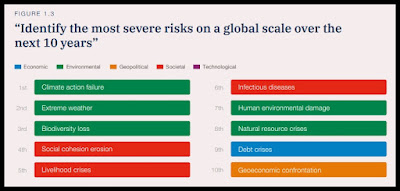An organization called the World Economic Forum has long been issuing an annual report on global risks. In a post on this blog way back in 2013, I reviewed the World Economic Forum's 2013 report on global risks. Listing technological risks and economic risks over the next ten years, the Forum failed to foresee substantial risks from a pandemic. Its 2013 report listed "Vulnerability to Pandemics" as being of below-average likelihood in the next ten years.
A look at the World Economic Forum's 2019 report on global risks also shows a failure to alert us to the some of the biggest global economic hazards the world faced between 2020 and 2023. The 2019 report gave us the chart below. The only mention of a pandemic is a red diamond in the top left quadrant, one labeled "spread of infectious diseases." This was rated as having a "below average" probability. In the chart below we see no explicit mention of war as a global risk. There is a mention of "interstate conflict," but that is a vague term. Inflation is listed as having a below-average risk (with its opposite, deflation, having the same risk).
The 2019 report listed the following as the top 10 global risks in terms of likelihood:
Oops, there was no mention of a pandemic as one of the top 10 global risks in the next 10 years. There was also no mention of either war or inflation as one of the biggest global risks. The three biggest risks the global economy has faced in the past three years seem to have been the COVID-19 pandemic, inflation, and the risk from the Russian invasion of Ukraine.
The 2020 World Economic Forum report on global risks did not do any better. It gave us estimates of risk that were not very different from the estimates shown above. Below is what the 2020 report listed as the top 10 global risks in the next 10 years:
Again, there was no mention of a pandemic as one of the top 10 global risks in the next 10 years. There was also no mention of either war or inflation as one of the biggest global risks. The report had a chart looking very similar to the first chart shown in this post, and in that chart both "Unmanageable inflation" and "Deflation" were listed as risks of below-average likelihood, with deflation listed as the more likely of the two.
In my 2013 post on the World Economic Forum's 2013 report on global risks, I chided the report for its overlooking the threat of nuclear war, stating this:"My only objection to this summary graph is, again, that it inexplicably ignores the risk with greatest impact: the risk of nuclear war. A conservative estimate of the risk of a nuclear war is 1 percent per year. The United States has approximately 2150 active nuclear weapons (7700 in all), and Russia has 1800 (8500 in all). Every year those weapons continue to exist, there is a chance of nuclear war, through things such as a software error, a mechanical error (as in Fail Safe), a deliberate launch of weapons by a sub or missile base commander afflicted by insanity or rage (as in Dr. Strangelove), or one side misidentifying something as a nuclear attack (such as happened in 1995, described here). Nuclear war should have been listed as the threat with greatest impact."
The 2020 World Economic Forum report on global risks did risk "weapons of mass destruction" as number 2 on its list of risks with the greatest impact, thereby partially correcting the strange omission I had noted in my 2013 post. But that 2020 report failed to mention conventional war as one of the 10 most likely risks.
In the 2021 World Economic Forum report on global risks we see them starting to get things right. There is a chart with the same format as the first chart shown in this post. Now suddenly we see a red diamond labeled "Infectious diseases" at the top right of the chart, indicating a risk of the highest likelihood. The diamond labeled "Deflation" has changed into a diamond labeled "Price instability," which covers both inflation and deflation. Now we see the 10 most likely global risks listed as below:
Finally, we see what could be a reference to international war (described as "interstate relations fracture") listed as one of the ten most likely results. But the improvement of the 2021 global risks report wasn't anything much to brag about. COVID-19 had been declared a pandemic by early 2020, and by the year 2021 Russia was loudly threatening to invade Ukraine, something it did in February 2022.
The 2021 global risks report failed to alert us to the risk of inflation. The report only mentioned inflation twice, each time in a very vague way in which inflation is described as price instability that could be either inflation or its opposite (deflation). Inflation in the US rose to 4.7% in 2021, and 9.1% in 2022.
The 2022 global risks report of the World Economic Forum has this figure:
None of the risks listed above include a mention of inflation, which was 9.1% in 2022 in the US. None of these "most severe risks on a global scale over the next 10 years" include an explicit mention of the risk of conventional war or nuclear war. This makes no sense. The world still has thousands of nuclear weapons that are vastly greater risks in the next ten years than almost every item listed above. What kind of "nuclear weapons amnesia" is going on here? The war between Russia and Ukraine (which is receiving heavy military assistance from the US and Europe) makes the threat of nuclear warfare worse than it has been for quite a few years.
All in all, it seems that the World Economic Forum's record of forecasting risks is not terribly impressive.






No comments:
Post a Comment